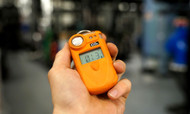3 Ways To Test Your Portable Gas Monitor
11th Dec 2023
Portable gas monitors detect the presence and concentration of hazardous gases in the environment. Ensuring the accuracy and functionality of these devices is crucial to maintaining safe working conditions, meeting regulatory standards, and preventing health hazards. Learn three ways to test your portable gas monitor and the importance of each method.
Bump Testing for Functionality
Bump testing exposes your monitor to a known concentration of gas, typically from a cylinder of calibration gas, to verify that the alarm triggers as expected. To know how often you should perform a bump test, follow your equipment manufacturer’s recommendations and your facility’s requirements based on the gas type.
If your gas monitor fails to trigger an alarm during a bump test, that may indicate there’s an issue with the sensors, hardware, or software. In this case, you should perform a full calibration or consult an authorized service provider to diagnose and resolve the problem.
Daily Calibration Checks for Accuracy
Daily calibration checks are essential to test your portable gas monitor’s performance. While bump tests verify that a gas detector is functioning correctly and that the alarms are operational, calibration tests ensure the gas monitor provides accurate readings.
Calibration tests involve adjusting the handheld gas detector’s response to a known concentration of the target gas, ensuring its ability to accurately measure and display gas levels. By conducting daily calibration checks, you can be confident in your gas monitor's readings and make informed safety decisions based on that information.
The Importance of Accuracy
Accurate gas detectors ensure the safety and health of employees in workplaces exposed to hazardous gases by providing precise measurements essential for risk assessment and safety protocols. A minor inaccuracy can lead to serious consequences, including health complications or even fatalities due to undetected gas leaks or exposure to toxic gases.
Full Calibration
A full calibration is a more comprehensive procedure needed to maintain your gas monitor's accuracy to the highest degree. It typically involves adjusting the sensors' responses to multiple known concentrations of gas, which also includes the monitor's alarm setpoints. You should perform a full calibration every six months, or as often as the manufacturer recommends. It’s also necessary after failed bump tests or daily calibration checks.
The full calibration procedure will vary based on the type of monitor and manufacturer guidelines. However, it generally involves the following steps:
- Expose the monitor to a zero-gas source to establish a baseline reading.
- Introduce the monitor to a known concentration of the target gas, and adjust the reading to match that concentration.
- Repeat this process for each type of gas the monitor detects and any additional alarm setpoints.
Regular testing of your portable gas monitor is a necessary step for ensuring its accuracy and reliability. Perform bump tests, calibration checks, and full calibration tests to guarantee the safety of your work environment. Always adhere to the manufacturer's guidelines and industry standards when performing these tests to maintain the optimal functionality of your device.

